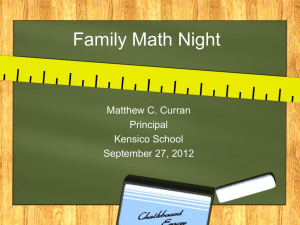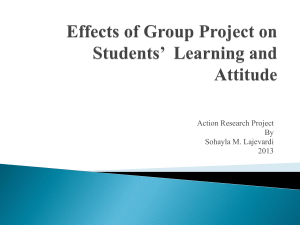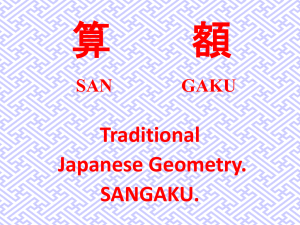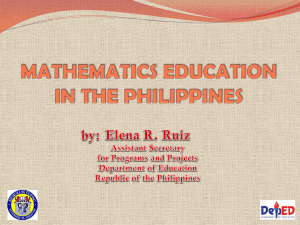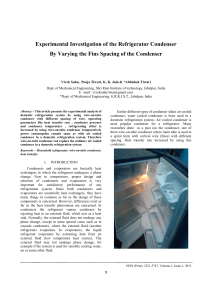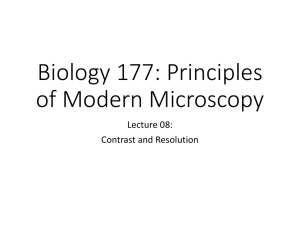putting_why_back_into_science_and_math_education
advertisement
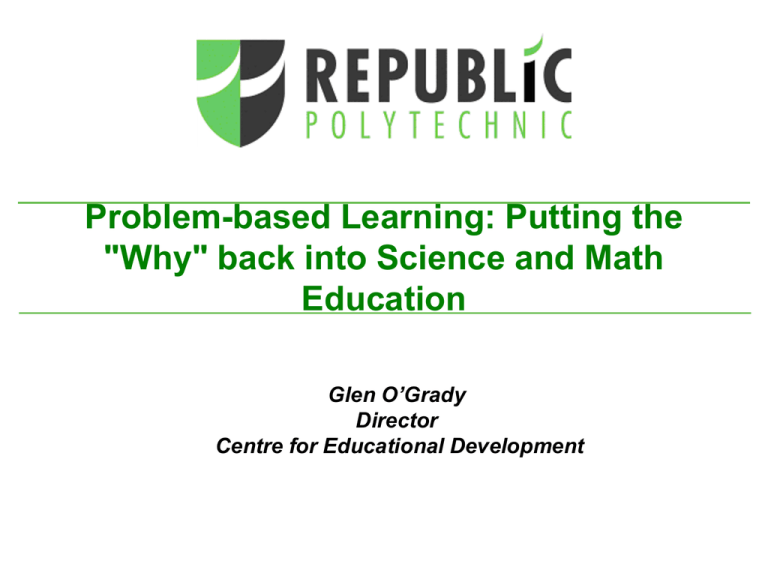
Problem-based Learning: Putting the "Why" back into Science and Math Education Glen O’Grady Director Centre for Educational Development Crisis in Science/Math Education? • Widespread scientific illiteracy amongst the general public • Shortage of good science teachers • A reluctance on the part of pupils to pursue scientific subjects Situation in Malaysia “In the year 2000, there were only 28% of the secondary school students in the science stream. The figure is low and greater efforts need to be put in bringing the figure to the 60% as targeted by the government”. Professor Dr. Hassan bin Said (2000) Trends in International Mathematics & Science Study (1999) Math Science 18 Latvia-LSS 18 United States 1 Singapore 1 Chinese Taipei 19 United States 19 New Zealand 2 Korea, Republic of 2 Singapore 20 England 20 Latvia-LSS 3 Chinese Taipei 3 Hungary 21 New Zealand 21 Italy 4 Hong Kong SAR 4 Japan 22 Lithuania 22 Malaysia 5 Japan 5 Korea, Republic of 23 Italy 23 Lithuania 6 Belgium-Flemish 6 Netherlands 24 Cyprus 24 Thailand 7 Netherlands 7 Australia 25 Romania 25 Romania 13 Australia 13 Slovenia 26 Moldova 26 Israel 14 Finland 14 Canada 27 Thailand 27 Cyprus 15 Czech Republic 15 Hong Kong SAR 36 Philippines 36 Philippines 16 Malaysia 16 Russian Federation 37 Morocco 37 Morocco 17 Bulgaria 17 Bulgaria 38 South Africa 38 South Africa National Center for Education Statistics Science Proficiency in US (2000) • Grade 4 (9-10 yr olds) The percentage of students who performed at or above the Proficient level was 28 percent 38% were below basic (California 62%) • Grade 8 (13-14 yr olds) The percentage of students who performed at or above the Proficient level was 30 percent. 41% were below basic (California 55%) National Center for Education Statistics Math Proficiency in the US (2003) So what’s the Problem? There's a tug-of-war between those who feel that math and science education should be aimed at a clever elite, and those who want everyone to be able to do the subject. “We still force two cultures on our children aged 16, we ask them do you stand for Humanities or the Sciences” Sir Peter William Chairman of the Engineering & Technology Board, UK. Science is taught as a collection of (assumed-to-be) facts, in other words dogma, which is an anathema to the practice of Science. To unlearn the dogma of Science is very difficult, it has been said that: “You cannot reason a person out of a position he did not reason himself into in the first place.” Is the world round rather or flat? 1150 1st year Polytechnic students all said they believed that the earth was round not flat, however none of the 1150 were able (or willing) to state what was the scientific evidence that supported this proposition Most said they knew it was round because: • they read it in a book, • seen pictures on TV, or • their teachers had told them. Teaching Math in 7 Countries (Eight- Grade Classes): Video Study (1999): Common Findings • In all of the countries, math was often taught through solving problems; at least 80% of lesson time, on average, was devoted to solving math problems. • Math lessons were organized to include some wholeclass work and some individual or small-group work. The most common pattern was for students to work individually, rather than in pairs or groups. • On average, lessons included some review of previous content as well as some attention to new content. • At least 90 % of lessons made use of a textbook or worksheet of some kind. • Teachers in all of the countries talked more than students, at a ratio of at least 8:1 words. National Center for Education Statistics Types of Math Problems used in Eighth-Grade Classes National Center for Education Statistics "school science education must reflect science as it is practiced," The U.S. National Committee on Science Education Standards and Assessment (1992) Solution? Problem-based Learning (PBL) an alternative model for students to learn and teachers to teach? Instruction-based Problem-based Teacher Centred Student Centred Syllabus Subject Z Subject X Subject X Subject X Teacher Dissemination of Knowledge Instruct, discipline, assess Students The Problem Team members (Curriculum) Student Construction of Knowledge Facilitator Prior Knowledge The Process of PBL • Problem (to triggers learning) • Students specify: – what they know about the problem, – what they don’t know – what they need to find out • Student work together in teams to do research • Presentation of findings • Assessment & Reflection Example of PBL in Action Problem Based Learning at the Republic Polytechnic One Day, One Problem Approach RP-PBL: 1st meeting • Class of 25, 5 teams of 5 students • Presented a problem • Students under the guidance of the facilitator work on defining the problem and identify issues they will do research on. • Approximately 1 hour RP-PBL: 1st Breakout Student work individually and in their teams to: – Find and review resources – Begin to develop tentative solutions for the problem – Refine their definition of the problem RP-PBL: 2nd Meeting • Meet with the facilitator who checks on their progress • Focus on any difficulties students may be having • Helps students to develop learning strategies RP-PBL: 2nd Breakout • Student continue to work in their teams • Review resources • Develop a solution/ explanation based upon their shared understanding • Produce a presentation • 2-3 hours RP-PBL: 3rd Meeting • Meet with the facilitator • Students present their solutions/explanations • Students observe how others have solved the problem • Facilitators probes and critique these solutions giving additional information where necessary • Students further check their understanding by doing a quiz focussed on the key issues Assessment • • • • • • Presentations Artefacts Self Evaluation Peer Evaluation Reflection journal Quiz Feedback everyday – Written feedback – Daily grade derived in a holistically • Response to understanding test Examples of Triggers for Learning in Science • There is no authentic investigation or meaningful learning if there is no inquiry, or seeking an answer, solution, explanation, or decision. • Share how it plays out – What students did – How it demonstrated a better understanding of Science – What the facilitator/teacher did Is the world round or flat? • What did students do? – Responded to the question specifying at first what they believed – Recognised that they lacked necessary information to develop a more credible (scientific) explanation Students work • How does this demonstrate a better understanding of Science? – Importance of Evidence in Science in explaining the validity of facts • What the facilitator/teacher did – Question whether their “ordinary explanations” were sufficient to accept as scientific explanations – Provide help with resources Hang Float Sink Hang Float Sink • What did students do? – Respond to the curiousness of the activity they observed – Search for the relevant concept/idea – They used a scaffolding worksheet, a series of smaller research questions that helped facilitate students thinking through the process that leads to an understanding of Archimedes principle – Students work • How does this demonstrate a better understanding of Science? – Meaning is derived from making sense of an observation (concrete experience) • What the facilitator/teacher did – Questioning why they think what they do? – Expecting them to qualify their answers – Correcting students work after they had attempted the task of understanding for themselves – Expect a mathematical explanation Fractional distillation is a common process adopted in the petrochemical industry and other industrial processes. The following diagram shows a setup for fractional distillation Water out Fractionating column Liebig condenser Examine and describe the heat transfer process that happens in the condenser. Water in Distillate Miscible liquid Heat Condenser • What did students do? – Specify their ideas about the process – Presumed that heat…. Students work • How does this demonstrate a better understanding of Science? – Discover the complexity of the processes • What the facilitator/teacher did – Challenge them with an unexpected answer – Expect students to reason out their conclusions – Help them reconcile their common sense with a more scientific explanation Other tools for facilitating understanding Other tools for facilitating understanding Mathematics is more than just numeracy "Affective issues play a central role in mathematics learning and instruction. When teachers talk about their mathematics classes, they seem just as likely to mention their students' enthusiasm or hostility towards mathematics as to report their cognitive achievements." (McLeod 1992) “school mathematics is structured and delivered in such a way as to portray the values of the society in which it is delivered”. (Seah & Bishop 2002) Proposed Values for Mathematics Education 1. 2. 3. 4. 5. 6. Rationalism Empiricism Control Progress Openness Mystery Centre for Science, Mathematics and Technology Education, Monash Uni Students learn mathematics when they construct their own mathematical understanding • Emphasizing communications in mathematics teaching and learning in order to increase student discourse and promote student-teacher interactions • Using topics such as estimation, statistics, probability, and measurement in ways that are rich in connections to a variety of cultures. • Providing numerous opportunities for critical thinking, problem solving, and reasoning, which many students do not experience in school. • Building connections between learning in school and learning outside of school - in students' families and communities The U.S. National Council of Teachers of Mathematics' Curriculum and Evaluation Standards for School Mathematics (1989) The Debate rages on… The equivalence of learning paths in early science instruction: effects of direct instruction and discovery learning (To appear in Psychological Science, 2004) David Klahr Department of Psychology Carnegie Mellon University Milena Nigam Center for Biomedical Informatics University of Pittsburgh What is the affect of asking “Why”? • Emancipation of the learner from the constraints of learning in a way that encompasses how we really learn • Students access and consider claims of a variety of disciplines • Critical reflection including a philosophical and sociological critique of what is being learnt • The fostering of student independence and responsibility for learning Thanks glen_ogrady@rp.edu.sg http://discovery.rp.edu.sg/home/ced/research/papers.htm Everywhere on Earth, objects falling towards the center of the Earth always fall straight down (can only be true on a sphere). If you watch the Sun set, and at the very moment when the Sun is just below the horizon you climb quickly up a hundred feet, you will see the Sun again. It is hard to explain why you can see further when you climb higher, unless the Earth's surface curves downward away from you wherever you stand. The Earth casts a shadow on the Moon during a lunar eclipse. The shadow is round. What we know … Density has a part to play in the problem. Weight and height will increase when water is added into the jar Water will be displaced when water is in contact with the object Formula for density is D = M/V What We Don’t Know … What is buoyancy ? Does the weight increase because of the suspended bottle? Formula for pressure What affects the height of water level The Problem … Peter placed a large jar on a weighing scale and hung a heavy object from above so that it does not touch the jar but is inside the jar. Then he added water in steps of small measured equal quantities. After each step of adding water he took the reading on the weighing scale. He then plotted a graph of the weight of total water added versus the weighing scale reading. Predict the graph he will get and explain your answer. The Graph … Amount of liquid added (kg) 2.0 1.0 Reading on weighing scale (kg) 1.0 2.0 What we discovered Formula • Pressure = density x height buoyancy force cancel each other out. This means that the boat is displacing an amount of liquid that weight as much as the boat does ... Pressure = force / area http://van.hep.uiuc.edu/van/qa/section/Underwater_and _in_the_Air/Pressure/20030103154058.htm Condenser Examine and describe the heat transfer process that happens in the condenser. Team 3 Heat Transfer Heat, a form of kinetic energy, is transferred in three ways: conduction, convection, and radiation. Heat can be transferred only if a temperature difference exists Only in the direction of decreasing temperature. Question 3 Q/t=kA( T/d) Difference in temp ( reason for heat transfer): 308K – 296K = 12K Amount of energy able to transfer by glass in a hour: Difference in temp/the thickness X thermal conductivity (heat lost per sec ) X area X 60 X 60 = 12/0.004 x 0.9 x (1.5 x .0.5 )x (60 x 60) = 7290000W =7290kW The Graph Distance Travelled (m) Distance vs Temperature 0.12 0.1 0.08 Series1 0.06 0.04 0.02 0 299 300 301 302 303 Temperature (K) 304 Distance travelled (m) Distance vs Temperature 3.02 3 2.98 2.96 Series1 2.94 2.92 2.9 2.88 346.2 346.4 346.6 346.8 347 347.2 Temperature (K) The Heating Process In The Condenser Conduction is the transfer of heat through a substance from a higher to a lower temperature region Water is drain out at the top to provide further conduction back to the water vapour in the inner tube. Water out Liebig condenser Water in Distillate When steam touches the inner tube of the condenser, conduction occurs. Heat is transferred to the wall of the inner tube by the steam then to the water in the outer tube.




